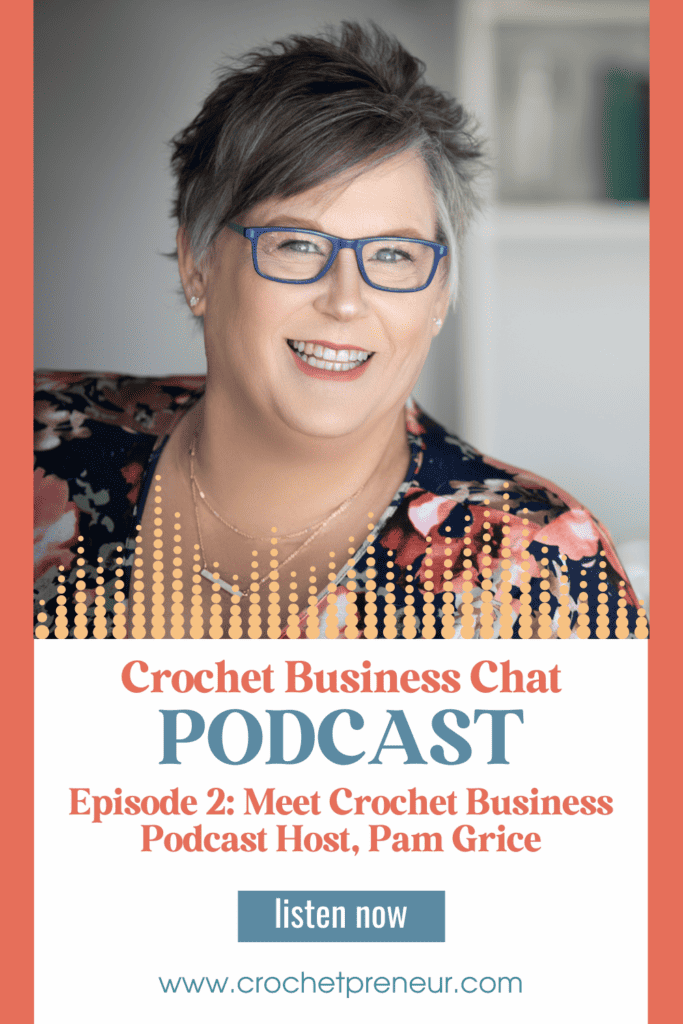In the age of technology, some crafters and crocheters are finding that they don’t want to sell online. Instead, they’re looking for ways to sell crafts offline and in person. Here are my top 10 tips for selling crochet locally!
Yes, everyone is selling crafts online these days and it’s a great way to build an international business. But what about folks who don’t like technology, don’t have access to the internet or, simply, would prefer to sell their crafts locally?
Well, while aside from craft fairs (which we all know about and which may not be happening this year), it seems the skill of in-person selling and advertising is a lost art.
But it’s not gone yet! I’d love to help.

Hi, I’m Pam Grice, founder of the Crochetpreneur Business Academy and CEO of my own crochet design and product-based business. As a crochet business coach, I help crochet business owners turn yarn into money and go from overwhelmed hobbypreneur to to profitable crochet CEO with the CBA™ Success Method.
And I’m here to help you tackle this issue, too. let’s take a peek…
Top 10 Ways to Sell Crafts Locally Without Craft Fairs
1. Boutique Shops on Consignment
Back in the day when I used to sell my art, I scoped out a local boutique in an artsy part of town and asked to speak with the manager. Gutsy, right?!
Well, you know how I am about owning your awesome! I really thought my artwork and art-jewelry would sell. So, I toted a box full of paintings and a small jewelry display into the shop and gave my pitch.
I was so excited that she was interested.
Right then and there, she grabbed a contract, we worked out a commission plan, and we agreed on the retail pricing of the items.
It worked great.
Every month I would restock with prints, pendants, and one or two pieces of original art and picked up my check. There’s no reason this wouldn’t, also, work with crochet…just find boutique that target the same audience that you do.
2. Boutique Shops on Wholesale
Similar to selling on consignment, you can, simply, pack up your most beautiful products and meet with the manager of a local boutique. Pitch your items and see if you can come up with a situation that works for both of you.
Be sure to know what rate you are willing to discount your products in order to make wholesale marketing worth your time.
For me, working with shops throughout the country on a wholesale basis, I knew that I could only discount my products by 35% and still make a profit. While many people say you MUST offer 50% off your retail pricing in order to sell wholesale, I’ve found that not to be the case.
Aside from the 35% retail price reduction for bulk purchases, I did require a minimum purchase of $250 in product. This is what worked for me and I was able to create an ongoing relationship with these businesses and could rely on an influx of cash each September as my wholesale customers order to replenish their fall inventory.

special designed for handmade sellers
Get Your Product Pricing Calculator
Opt to price your products based on time, stitches, or yardage and find the suggested retail and wholesale prices PLUS get graphic charts showing your per-product profits. It’s an indispensable tool for all handmade sellers!
3. Farmer’s Markets
The clientele who visit farmer’s markets are often the same customers who appreciate the quality and skill of a handmade artist.
And more and more markets are opening up to a wide variety of businesses – not just farmers and ranchers.
So, check with your local farmer’s market to see if there are opportunities for you to pitch a tent and share your amazing products alongside fresh fruits and veggies, cider, and other home-crafted treats.
4. Pop-up Shops
This past winter, I was renting a space a local co-working office in the small town where we live. The town has a monthly First Friday event where all the downtown shops stay open with special sales, displays, and a variety of entertainment.
I was so blessed when the owners of the office asked if I’d like to set up a pop-up shop for the November First Friday event.
I was thrilled because all my craft shows had been cancelled and I was left with inventory that was going to have to stay in storage throughout what was supposed to be the busiest selling season.
So, I grabbed my hats and scarves and my pared-down craft fair setup and created a display right there in the middle of the office.
It worked out so well and created such a cozy atmosphere that they asked me to leave it there through the end of December and it certainly helped make up for the lost revenue due to market cancellations.
Some places you might set up a pop-up shop are: shopping center parking lots (provided you live in a mild climate), shopping mall kiosks, or anywhere you can predictable estimate that your target customer will be hanging around.
Note: Remember to always check local ordinances to see if you need a peddling or other license before setting up a pop-up shop.
5. Facebook Marketplace
Yup, Facebook Marketplace has come a long ways since the ‘old days.’ No longer is it considered the flea market of online sales. Now, it is an easy way to get your product out in front of your target customer…and you can even arrange for a quick porch pickup!
One consideration – while this is a local sales strategy, the actually selling is happening online. So, you’ll need to pay attention to all those same concerns you’d have selling in an online shop.
Be sure to have great lighting for your photographs, great copy for your description, and really sell the emotion you want the customer to have when he/she purchases your item.
Increase perceived value with your great photos and copy and, then, price your product according to what works best for you and for your customers and it will be a win/win.
6. Co-op Marketplaces
More and more towns are embracing the idea of having a one-stop shop of featured, local artisans – a co-op marketplace.
Various co-ops operate differently so you’ll have to connect with the manager there, but it typically entails paying a fee for your booth space, a small commission on sales, and a commitment to work at the co-op a few times a month.
If you love to connect with your customers, network with other artisans, and have time for face-time at the shop, this would be a great opportunity to share your products and make some friends in the process.
7. In-home Parties
If in-home parties are allowed in your area, this is a great way to get your product in front of several potential customers at once.
The thing I love about in-home parties are the lively atmosphere, the squeals of “Oh my gosh, you look so cute in that…you have to buy it!”, and the general excitement about supporting local artisans.
Take a page from your local home-party gurus like Tupperware and Pampered Chef – create incentives for the hostess, have games where guests can win small prizes, and enlist the help of guests to model your products a la New York’s fashion runways.
Have fun with it and be sure to bring your credit card processor.
8. Hospital Gift Shops
Hospitals need all the coziness they can get and your products can meet the need by providing the opportunity to bring comfort to a patient, joy to a new momma, or a soft embrace to warm a baby
Much like consignment boutiques, you’ll need to connect with the manager, share why your products would be a good fit, and prepared to draw up a contract and replenish the shop periodically.
Some ideas for hospital gift shop inventory might be baby booties, blankets, and hats, slippers, fingerless gloves, lap blankets, wheelchair blankets, and prayer shawls.
For baby items, be sure they meet safety standards before placing them for sale.
9. Tourist Destinations
I’ve lived in a tourist destination for the past 30 years. Even though we moved recently, our little downtown is bursting with antique shops, gift shops, and special Colorado-made boutiques.
Tourists love locally-made products. So, these are a great place to stock with your specially, local-made tags so you can send the tourists home with some special right from your hometown.
Some tourist destinations that might provide great opportunities for including your products for in-person sales are museums, zoos, art galleries, tourist attractions (like the Royal Gorge Bridge), cafes, and coffee shops.
10. Your Target Customer’s Hangout
Yes, this list could go on and on – there’s no end to possibilities when you ask yourself where does my target customer hang out?
Is she at the local salon? Make some gorgeous hats that will look amazing with her new do.
Is she at the coffee shop? Make some fingerless gloves to keep her fingers warm when she leaves with her cuppa joe.
Is he flying his drone at the local park? Men’s fingerless gloves and a balaclava will keep him warm no matter how cold it gets.
Are they at the local gift shop looking for a special home decor item to grace their newly remodeled fixer-upper? Make some farmhouse style baskets and they’ll be sold!
See, easy peasy.
Simply ask the question….where is my person? And, is there something in my product line that they’d love to walk away with, that will meet a need, even if that need is, simply, “I need some retail therapy!”?
Then, make that thing and make it irresistible.
Get Access to Our Entire Vault of Crochet Business Boosting Resources!








